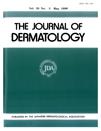Sweat Gland Adenoma with Predominant Myoepithelial Differentiated Features: Case Report and Immunohistochemical Study
Abstract
A 56-year-old man presented with a subcutaneous mass adjacent to the sternoclavicular joint region, which had predominant spindle-shaped myoepithelial cells and a small number of tubular or trabecular epithelial cells that resembled eccrine differentiation under a light microscope. Immunohistochemical studies showed positive staining for muscle-specific actin and vimentin in the myoepithelial cells, but staining was negative for S-100 protein and keratin. The tubular and trabecular epithelial cells stained positively for keratin, EMA and CEA. We believe that this rare tumor had the potential for biphasic differentiation and should be differentiated from other biphasic differentiated or mixed tumors in this site. Immunohistochemical staining was useful for diagnosis and differential diagnosis.




